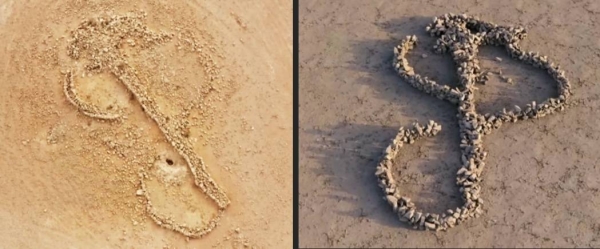The recent discovery of hundreds of thousands of ancient tombs in Saudi Arabia has shed new light on the history of the Arabian Peninsula, particularly in the Kingdom of Saudi Arabia. Dr. Eid Al-Yahya, a renowned Saudi field researcher and anthropologist, has played a crucial role in uncovering these intriguing tombs, some of which are massive in size and unique in design. Among the most fascinating patterns discovered is the “Pharmacy and Medicine” symbol, which bears a striking resemblance to modern pharmacy and medicine symbols. This particular pattern, found in Mount Tuweq, reflects the beliefs and philosophies of the people of the Arabian Peninsula related to life, health, and healing.
The tomb shaped like a snake coiling around a staff on top of Mount Tuwaiq in the city of Al-Ghat is a notable example of the unique architectural designs found in Saudi Arabia. This tomb, resembling the symbol of pharmacy and medicine, showcases the cultural significance of the snake in the region. The connection between the design of this tomb and the symbolism of the snake in Mesopotamia further emphasizes the historical and cultural significance of these ancient tombs. The depiction of the snake coiling around a rod is similar to the symbol of the god Ningišzida, the Mesopotamian deity associated with medicine and healing.
Ancient Mesopotamian texts and artistic scenes have provided additional insights into the symbolism of the snake and staff in relation to medicine and healing. The Sumerian king Gudea’s vase, featuring two intertwined snakes encircling a staff-like symbol, illustrates the association between the serpent and medicine in Mesopotamian culture. The god Ningišzida, symbolizing healing and medicine, was a prominent figure in Mesopotamian myths and beliefs. The cuneiform writings and symbols related to medicine and pharmacy reinforce the connection between the snake, staff, and healing practices in ancient civilizations.
The discovery of artistic scenes depicting serpents on stone vessels in the Arabian Peninsula, particularly in Saudi Arabia, further strengthens the link between the snake symbol and ancient beliefs in the region. Scenes showing serpents on stone vessels found in archaeological sites in Saudi Arabia suggest a continuity of symbolism related to healing and medicine. These scenes, along with the tomb of pharmacy and medicine in Saudi Arabia, demonstrate the cultural significance of the snake and staff symbol in the region’s history and beliefs.
The adoption of the serpent and staff symbol by Greek and Roman civilizations from Mesopotamian culture highlights the widespread influence of ancient beliefs and practices. The symbol of the snake coiled around a staff, associated with the god Asclepius in Greek and Roman mythology, has roots in the symbolism found in the tomb of pharmacy and medicine in Saudi Arabia. The continuity of this symbol in different cultures and time periods underscores its enduring significance in the history of medicine and healing practices.
In conclusion, the discovery of ancient tombs with unique architectural designs in Saudi Arabia has provided valuable insights into the cultural and historical significance of the region. The symbolism of the snake and staff in relation to medicine and healing practices reflects the shared beliefs and traditions of ancient civilizations in the Arabian Peninsula and Mesopotamia. The research and discoveries made by Dr. Eid Al-Yahya and his team highlight the importance of preserving and understanding the rich heritage of Saudi Arabia and its contribution to the history of humanity.



























